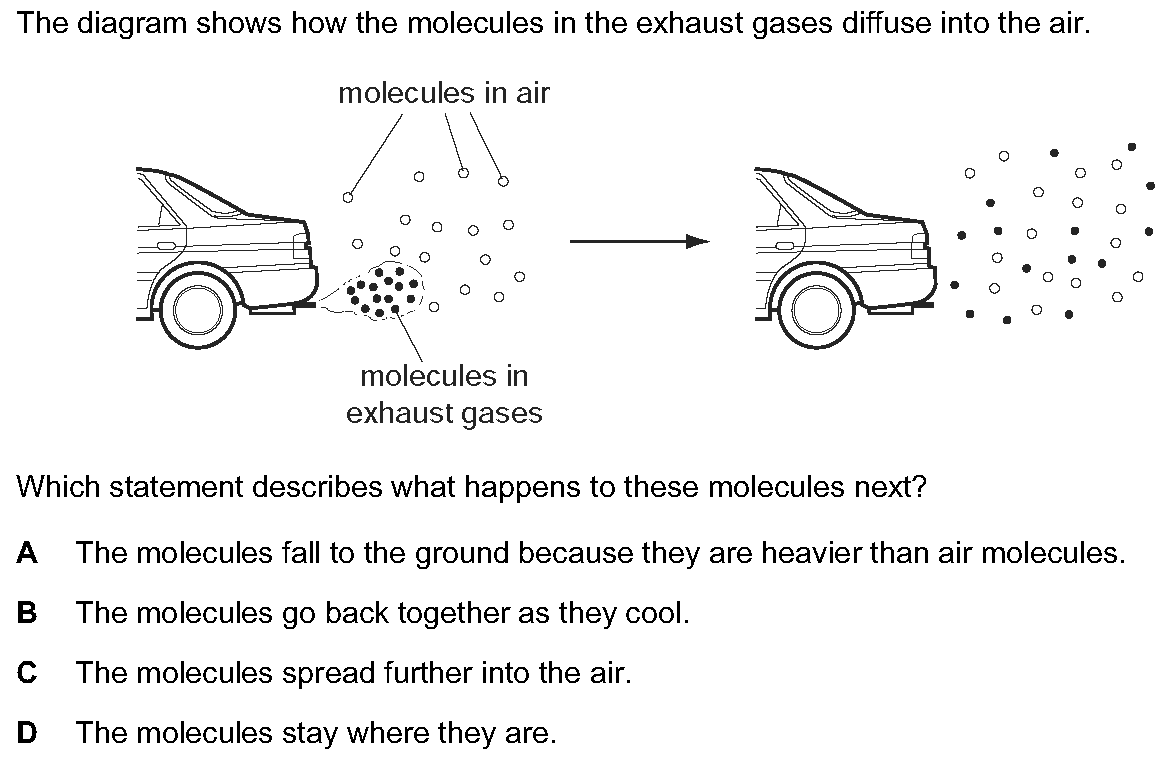
Q1:
Cambridge IGCSE Chemistry - 0620 - Core Paper 1 2009 Summer Zone 2
Questions:
1/40

Topic: CH1 - STATES OF MATTER
Solution
Solution is C

PRACTISE
Similar Questions

LEARN
Concepts with Sparky

More Questions from this Topic
MCQ
CH1 - STATES OF MATTER
Which statement about the electrolysis of molten lead(II) bromide is correct?
2011
 Summer
Summer
 Summer
Summer
 3
3
MCQ
CH1 - STATES OF MATTER
The diagram shows an unsuccessful experiment to nickel plate a pan. Which change is necessary to plate the pan with nickel?
2012
 Summer
Summer
 Summer
Summer
 3
3
MCQ
CH1 - STATES OF MATTER
What will be produced at the anode and at the cathode, if molten potassium chloride is electrolysed? [Table_1]
2014
 Summer
Summer
 Summer
Summer
 4
4
MCQ
CH1 - STATES OF MATTER
The diagram shows that two gases are formed when concentrated hydrochloric acid is electrolysed using inert electrodes. Which row correctly describes ...
2012
 Summer
Summer
 Summer
Summer
 4
4
MCQ
CH1 - STATES OF MATTER
Molten lead(II) bromide is electrolysed as shown. Which ions are discharged at each electrode?
2009
 Summer
Summer
 Summer
Summer
 2
2
MCQ
CH1 - STATES OF MATTER
Which of these elements could be formed at the anode when a molten salt is electrolysed?
2009
 Summer
Summer
 Summer
Summer
 2
2
MCQ
CH1 - STATES OF MATTER
Concentrated aqueous sodium chloride, concentrated hydrochloric acid and molten lead bromide were separately electrolysed in experiments 1, 2 and 3. ...
2013
 Summer
Summer
 Summer
Summer
 1
1
MCQ
CH1 - STATES OF MATTER
Three gas jars contain carbon dioxide, hydrogen and oxygen, as shown. Which one of the following tests could be used to discover which gas is in eac...
2012
 Summer
Summer
 Summer
Summer
 3
3
MCQ
CH1 - STATES OF MATTER
The diagrams show the arrangement of particles in three different physical states of substance X. Which statement about the physical states of substan...
2011
 Summer
Summer
 Summer
Summer
 2
2
MCQ
CH1 - STATES OF MATTER
The diagram shows how the molecules in the exhaust gases diffuse into the air. Which statement describes what happens to these molecules next?
2009
 Summer
Summer
 Summer
Summer
 8
8
More Questions from year 2009
MCQ
CH1 - STATES OF MATTER
The diagram shows how the molecules in the exhaust gases diffuse into the air. Which statement describes what happens to these molecules next?
2009
 Summer
Summer
 Summer
Summer
 8
8
MCQ
CH2 - SEPARATING SUBSTANCES
A student takes 2 g samples of calcium carbonate and adds them to 20 cm^3 samples of dilute hydrochloric acid at different temperatures. She measures ...
2009
 Summer
Summer
 Summer
Summer
 1
1
MCQ
CH2 - SEPARATING SUBSTANCES
The diagram shows the paper chromatograms of four substances, W, X, Y and Z.Which two substances are pure?
2009
 Summer
Summer
 Summer
Summer
 5
5
MCQ
CH3 - ATOMS AND ELEMENTS
An element S has the proton number 18. The next element in the Periodic Table is an element T. Which statement is correct?
2009
 Summer
Summer
 Summer
Summer
 3
3
MCQ
CH3 - ATOMS AND ELEMENTS
Which numbers are added together to give the nucleon number of an ion?
2009
 Summer
Summer
 Summer
Summer
 1
1
MCQ
CH3 - ATOMS AND ELEMENTS
The electronic configuration of an ion is 2.8.8. What could this ion be?[Table showing options for $S^{2-}$ and $Ca^{2+}$]
2009
 Summer
Summer
 Summer
Summer
 2
2
MCQ
CH4 - ATOMS COMBINING
The diagrams show the structures of two forms, P and Q, of a solid element. What are suitable uses of P and Q, based on their structures?
2009
 Summer
Summer
 Summer
Summer
 4
4
MCQ
CH4 - ATOMS COMBINING
Element V forms an acidic, covalent oxide. Which row in the table shows how many electrons there could be in the outer shell of an atom of V? [Table_1...
2009
 Summer
Summer
 Summer
Summer
 5
5
MCQ
CH4 - ATOMS COMBINING
When sodium chloride is formed from its elements, each chlorine atom ...... 1 ...... one ...... 2 .......Which words correctly complete gaps 1 and 2?
2009
 Summer
Summer
 Summer
Summer
 5
5
MCQ
CH5 - REACTING MASSES AND CHEMICAL EQUATIONS
Nitrogen and hydrogen react together to form ammonia.$N_2 + 3H_2 \rightarrow 2NH_3$When completely converted, 7 tonnes of nitrogen gives 8.5 tonnes of...
2009
 Summer
Summer
 Summer
Summer
 1
1




 Share
Share




 Previous
Previous




